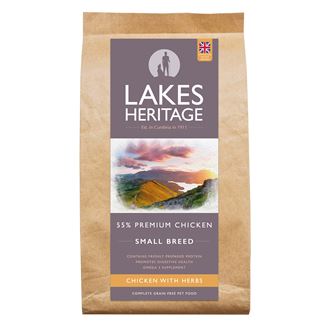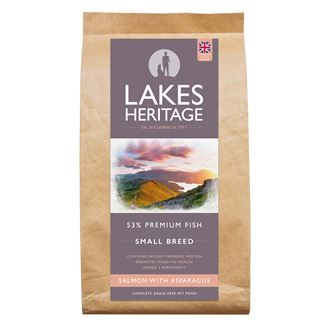Small Breed Dog Food vs Large Breed Dog Food
Regarding age and breed, there are notable differences in how you should feed dogs according to their size and activity level. A diet made for an active dog will be higher in fat, and that is why it's important not to give a less active breed the wrong type of food. What you feed your dog is of great importance and will affect their health as they continue to age.
At WCF Pet & Equestrian (also known as West Cumberland Farmers), we have put together some practical advice on how to feed small breed dog food vs large breed dog food. It is worth noting that your dog, whether large or small, should get all its nutritional needs from consuming a commercial super premium dog food.
What Size of Dog do you have?
Dogs come in many shapes and sizes, with large and giant breed dogs being two sizes that owners see as similar. If your dog is between 25kg to 44kg, they fall within the large breed category. This type of dog experiences a long growth period, reaching adult weight at 15 months. They usually have a slower metabolism and require a lot of walks. If your dog weighs over 45kg, it is considered a giant breed dog. Giant breeds go through a two-step growth phase and reach their adult size at 18 to 24 months.
The first six months see rapid growth for which they require a diet that is high in energy and nutrients, as well as being easy to digest. After this initial phase, muscular development takes place. Examples of a large/giant breed dog can include Great Danes, Rottweilers, and Saint Bernards.
Tips on Feeding Your Small Dog
A small dog can be a puppy or any fully grown small breed such as a Pug or Dachshund. A Puppy has nutritional needs that are much more expansive than an adult dog. That is because puppies need calories to fuel their energy requirements, and they also need the calories to support their growing bodies and bones.
Feeding an adult dog puppy food would put them at risk of having too many calories all at once, and giving a puppy an adult dog food will put them at risk of not having enough calories - this could lead to slowing or stunting of their growth.
Puppies will need fed small, frequent meals starting at about 3-4 times a day as they transition from milk to solids. After this period, they can begin eating twice a day which is usual for most adult dogs. Portion sizes are essential in maintaining the weight of your dog, regardless of its breed or age.
Overfeeding can lead to obesity which puts extra strain on the bones and joints and can lead to other serious health issues. The correct amount of the food you should be feeding your dog, according to their weight, will usually be on the back of their food packaging. If in doubt, talk to your vet.
The size of the kibble is relevant too. Remember that your small dog will have a smaller throat and jaw than a larger breed and may find larger chunks of food more difficult to swallow and chew properly.
Tips on Feeding Your Large Dog
Premium pet food for adult dogs helps with any health problems they are likely to suffer in older age. Larger breed dogs are prone to suffering from a joint strain, so the tailored recipes will often contain added glucosamine and chondroitin that support joint health.
Due to their adult size, large breed puppies have a different growth curve to smaller breeds and therefore have more nutritional requirements to support optimal growth and development. If large breed puppies grow too rapidly, this can cause issues with bones, joints, and muscles. Therefore, pet foods have been formulated specifically for large breed puppies to help support controlled growth.
With large breed puppies, pet owners need to take extra care compared to those who own smaller puppies. That is because of the high growth rate and energy requirements of a large breed puppy. This type of dog can be at risk in later life of developing issues with their hips and elbows because of how quickly they grow.
Larger
dogs that have a deep chest can commonly suffer from gastric torsion
that is extremely painful. The stomach twists and causes a build-up of
gases that become trapped inside. If this happens to your dog, their
stomach will look large, and your dog will be displaying symptoms such
as drooling, rapid breathing, and retching. It is an emergency, and you
need to contact your vet immediately. You can prevent this from
happening by helping them not to drink too much water when feeding. It
is also a good idea to portion out the food, making sure your dog is not
consuming it all at once. Eating slower and not exercising thirty
minutes before or after food will help reduce the risk of your dog
suffering from this unpleasant digestive issue.
Talk to your vet for advice about an appropriate pet food if you have a large breed puppy.
Switching to Adult Dog Food
We recommended that when a dog reaches 80% of its full adult size, the owner should consider switching them onto adult dog food. That can happen at different times and ages, depending on the breed of the dog. We advise that small dogs will reach this size first, around 9 to 10 months. Medium-sized breed dogs continue to grow until they are about a year old, and large breed puppies will reach 80% in size at around 12 to 16 months old.
Activity Levels
Activity levels should be taken into consideration when choosing what type of food to feed your dog. Speak to your vet if you are unsure of the best way to feed your pet.
Premium Pet Food
The price of premium pet food will cost a bit more but will probably be financially beneficial in the long run. That is because the ingredients will be of better quality, and they will likely be more easily digestible. As a result, your dog probably will eat less, and this, in turn, will save you money.
WCF Exclusive Premium Dog Food
WCF Pet & Equestrian has a range of premium foods for dogs available to buy online, and it's worth remembering that you can buy a bag of dog food in various sizes ranging from 2kg to 12kg. If you are looking for the best grain free puppy food, the best complete dry dog food, or the best dog food for sensitive stomachs, be sure to look on our website to see what we can offer.
Discover the benefits of grain free dog food and choose
from a range of mouth-watering recipes, including duck, chicken, salmon,
and beef dog food flavours. Shop the full range available for dog food, alternatively, visit one of our WCF Pet and Equestrian stores.


